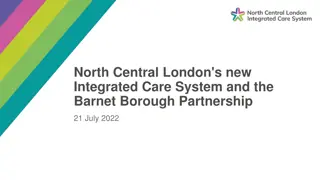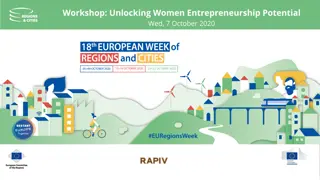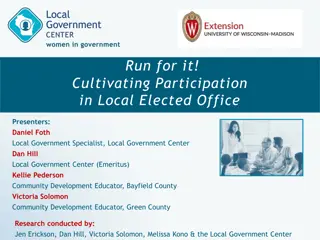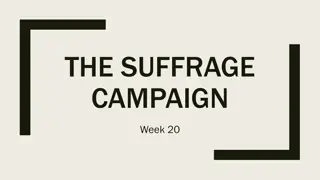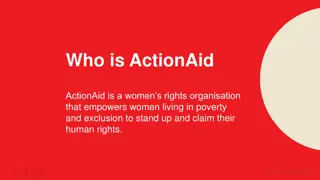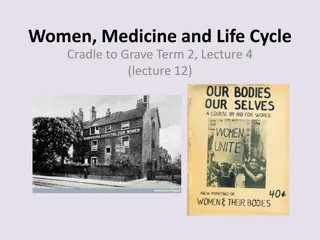Encouraging More Women to Cycle in London
Encouraging more women to cycle in London is crucial for achieving Transport for London's target of 1.5 million cycle journey stages by 2026. By addressing barriers such as traffic, safety concerns, and lack of confidence, initiatives can attract a more diverse range of cyclists. Infrastructure improvements, like the London Cycle Design Standards and Cycle Superhighways, play a key role in overcoming these barriers and making cycling more accessible to women and other underrepresented groups.
Download Presentation

Please find below an Image/Link to download the presentation.
The content on the website is provided AS IS for your information and personal use only. It may not be sold, licensed, or shared on other websites without obtaining consent from the author.If you encounter any issues during the download, it is possible that the publisher has removed the file from their server.
You are allowed to download the files provided on this website for personal or commercial use, subject to the condition that they are used lawfully. All files are the property of their respective owners.
The content on the website is provided AS IS for your information and personal use only. It may not be sold, licensed, or shared on other websites without obtaining consent from the author.
E N D
Presentation Transcript
1 Encouraging more women to cycle in London Claudia Corrigan Transport for London
2 Strategic context TfL have a target to reach 1.5 million cycle journey stages by 2026. Most current growth is coming from existing cyclists making more trips, relying on growth in this way won t help us reach our 2026 target. There is a need to attract a new and more diverse range of customers. As a public body - we need to implement initiatives that aim for an equitable distribution of cycling spend and tackle the barriers amongst underrepresented groups and communities Black and ethnic minority (BME) groups, women, lower income households, those with disabilities and older people are typically under-represented in cycling. There is a clear opportunity to increase the amount of women cycling in London. 13% of women in London cycle. 76% of women in London can ride a bike. 52% of women have access to a bike in their household.
3 Demographic profile of cyclists in London NRS Social grades NRS Social grades A upper middles class B middle class C1 lower middle class C2 skilled working class D working class E non working Gender: Men make more cycle trips than women and year-on-year growth is also much stronger for men Ethnicity: the cycle trip rate for white Londoners is substantially higher than for BAME groups. The growth rate has also been higher Age: Cycle trip rates peak for Londoners in their 30s and 40s. Highest growth rates in those between 30 and 50. Only 5% of those aged 65 and over cycle either regularly or occasional. Income: Londoners with higher annual household incomes are more likely to cycle, and have shown the highest growth
4 Barriers to cycling for women Barrier Too much traffic cited as the main reason for women not cycling Women are much less likely than men to think cycling is safe in London 1. Fear and vulnerability Barrier Women are much more likely than men to think that cycling in London is unappealing or that cycling is not for people like them 2. Identification and attractiveness Barrier Women are much less likely than men to feel confident cycling - 35% not confident compared to 16% men 3. Lack of confidence Motivators A desire to keep / get fit It s cheap / saves money It s quicker and enjoyable
5 Overcoming barriers to cycling Infrastructure London Cycle Design Standards published in 2014 Recognition that cyclists need space separated from high volume motor traffic and suggests three ways of achieving this: - Full segregation - Semi-segregation - Lower-traffic streets Delivery through Cycle Superhighway and Quietways programmes
6 Overcoming barriers to cycling Infrastructure Cycle Superhighways - Direct cycle routes into central London - 60km of segregated or semi-segregated routes delivered to date - Starting to see a new type of cyclist using these facilities including more women and children Quietways - Programme to deliver a network of cycle routes on low-traffic back streets - First route (Q1) launched in Summer 2016 - User feedback has been very positive "I had never thought of myself as a cyclist, but I've been on it most days for around a month now so I guess I am". (Female cyclist: Q1)
7 Overcoming barriers to cycling Behaviour Change Programmes Cycle Skills Cycle Grants London Breeze Network Prudential RideLondon Work with schools
8 Conclusion This is a time of investment in cycling in London and over the next ten years the profile and number of cycle trips will increase dramatically Delivery of infrastructure programmes over the next two years will change the cycle options available in London When these are delivered marketing and behaviour change programmes will be crucial Our investment will make cycling appealing and safer to all those who do not currently cycle
9 Thank You











